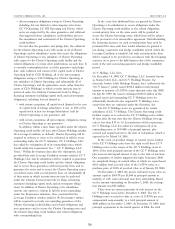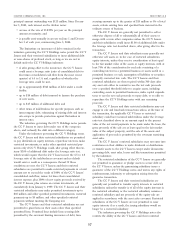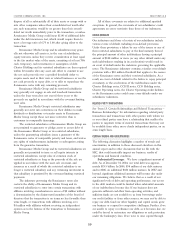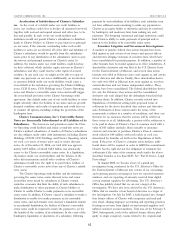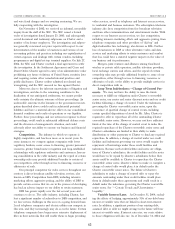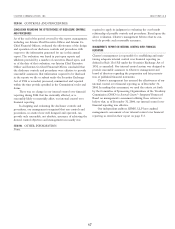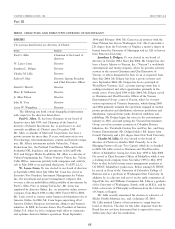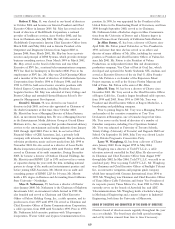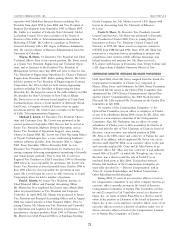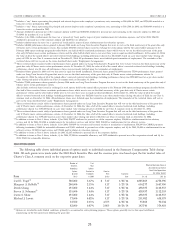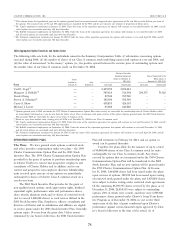Charter 2004 Annual Report Download - page 74
Download and view the complete annual report
Please find page 74 of the 2004 Charter annual report below. You can navigate through the pages in the report by either clicking on the pages listed below, or by using the keyword search tool below to find specific information within the annual report.
CHARTER COMMUNICATIONS, INC. 2004 FORM 10-K
Class A Common Stock and Notes Price Volatility. gramming, and unaffiliated commercial leased access program-
The market price of our Class A common stock and our ming. This carriage burden could increase in the future,
publicly traded notes has been and is likely to continue to be particularly if cable systems were required to carry both the
highly volatile. We expect that the price of our securities may analog and digital versions of local broadcast signals (dual
fluctuate in response to various factors, including the factors carriage) or to carry multiple program streams included with a
described in this section and various other factors, which may single digital broadcast transmission (multicast carriage). Addi-
be beyond our control. These factors beyond our control could tional government mandated broadcast carriage obligations
include: financial forecasts by securities analysts; new conditions could disrupt existing programming commitments, interfere with
or trends in the cable or telecommunications industry; general our preferred use of limited channel capacity and limit our
economic and market conditions and specifically, conditions ability to offer services that would maximize customer appeal
related to the cable or telecommunications industry; any change and revenue potential. Although the FCC issued a decision on
in our debt ratings; the development of improved or competitive February 10, 2005, confirming an earlier ruling against mandat-
technologies; the use of new products or promotions by us or ing either dual carriage or multicast carriage, that decision could
our competitors; changes in accounting rules or interpretations; be appealed or Congress could legislate additional carriage
new regulatory legislation adopted in the United States; and any obligations.
action taken or requirements imposed by NASDAQ if our There is also uncertainty whether local franchising authori-
Class A common stock trades below $1.00 per share for over 30 ties, state regulators, the FCC, or the U.S. Congress will impose
consecutive trading days. On December 31, 2004, our Class A obligations on cable operators to provide unaffiliated Internet
common stock closed on NASDAQ at $2.24 per share. service providers with regulated access to cable plant. If they
In addition, the securities market in general, and the were to do so, and the obligations were found to be lawful, it
NASDAQ National Market and the market for cable industry could complicate our operations in general, and our Internet
securities in particular, have experienced significant price fluctua- operations in particular, from a technical and marketing stand-
tions. Volatility in the market price for companies may often be point. These open access obligations could adversely impact our
unrelated or disproportionate to the operating performance of profitability and discourage system upgrades and the introduc-
those companies. These broad market and industry factors may tion of new products and services. The United States Court of
seriously harm the market price of our Class A common stock Appeals for the Ninth Circuit recently vacated in part an FCC
and our notes, regardless of our operating performance. In the ruling defining cable modem service as an ‘‘information service’’
past, securities litigation has often commenced following periods and remanded for further proceedings. The Ninth Circuit held
of volatility in the market price of a company’s securities, and that cable modem service is not ‘‘cable service’’ but is part
several purported class action lawsuits were filed against us in ‘‘telecommunications service’’ and part ‘‘information service.’’
2001 and 2002, following a decline in our stock price. The decision has been appealed to the United States Supreme
Economic Slowdown; Global Conflict. It is difficult to Court. However, if it is not reversed, the decision may lead to
assess the impact that the general economic slowdown and our having to contribute to the federal government’s universal
global conflict will have on future operations. However, the service fund, to comply with open access requirements, and to
economic slowdown has resulted and could continue to result in subject our high-speed data operations generally to other
reduced spending by customers and advertisers, which could common carrier regulations. As we offer other advanced services
reduce our revenues, and also could affect our ability to collect over our cable system, we are likely to face additional calls for
accounts receivable and maintain customers. Reductions in regulation of our capacity and operation. These regulations, if
operating revenues would likely negatively affect our ability to adopted, could adversely affect our operations.
make expected capital expenditures and could also result in our
INTEREST RATE RISK
inability to meet our obligations under our financing agreements.
These developments could also have a negative impact on our We use interest rate risk management derivative instruments,
financing and variable interest rate agreements through disrup- such as interest rate swap agreements and interest rate collar
tions in the market or negative market conditions. agreements (collectively referred to herein as interest rate
Regulation and Legislation. Cable system operations agreements) as required under the terms of the credit facilities of
are extensively regulated at the federal, state, and local level, our subsidiaries. Our policy is to manage interest costs using a
including rate regulation of basic service and equipment and mix of fixed and variable rate debt. Using interest rate swap
municipal approval of franchise agreements and their terms, agreements, we agree to exchange, at specified intervals through
such as franchise requirements to upgrade cable plant and meet 2007, the difference between fixed and variable interest amounts
specified customer service standards. Additional legislation and calculated by reference to an agreed-upon notional principal
regulation is always possible. amount. Interest rate collar agreements are used to limit our
Cable operators also face significant regulation of their exposure to, and to derive benefits from, interest rate fluctua-
channel carriage. They currently can be required to devote tions on variable rate debt to within a certain range of rates.
substantial capacity to the carriage of programming that they Interest rate risk management agreements are not held or issued
would not carry voluntarily, including certain local broadcast for speculative or trading purposes.
signals, local public, educational and government access pro-
64




